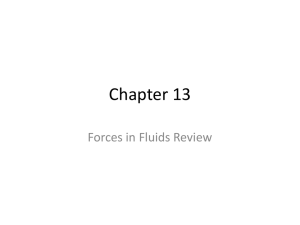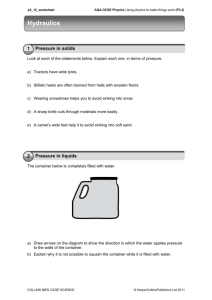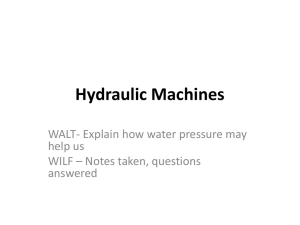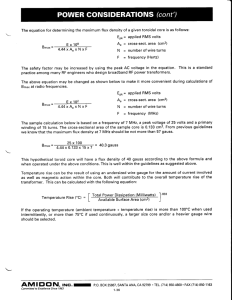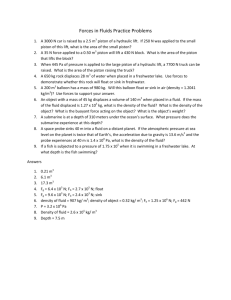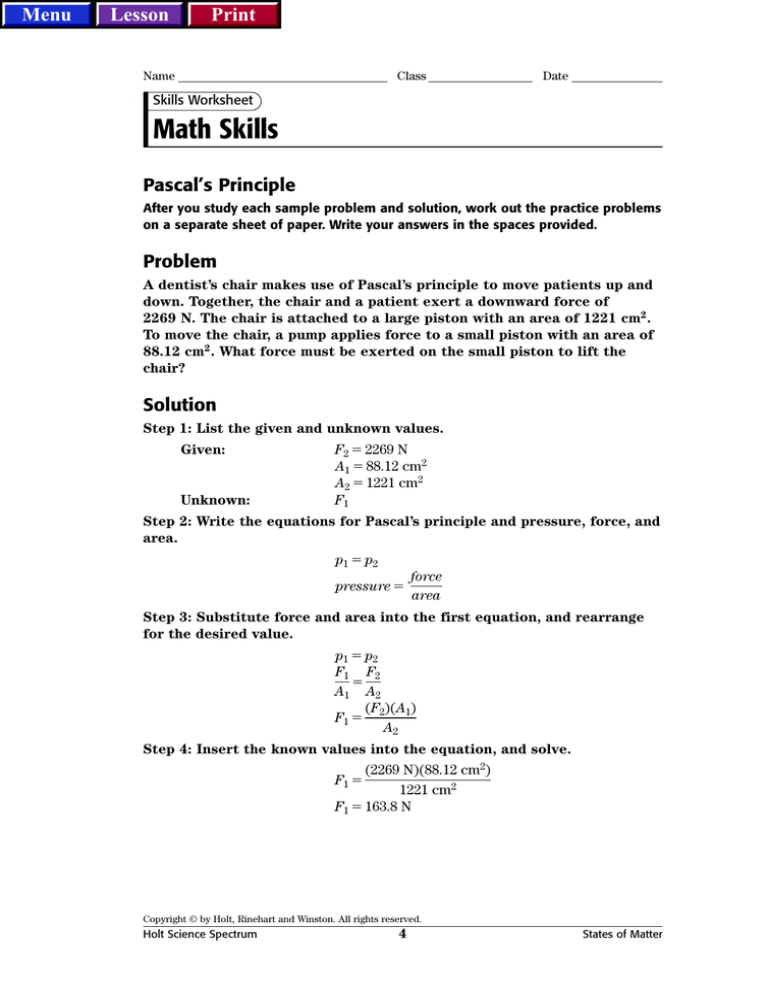
Menu
Lesson
Print
Name
Class
Date
Skills Worksheet
Math Skills
Pascal’s Principle
After you study each sample problem and solution, work out the practice problems
on a separate sheet of paper. Write your answers in the spaces provided.
Problem
A dentist’s chair makes use of Pascal’s principle to move patients up and
down. Together, the chair and a patient exert a downward force of
2269 N. The chair is attached to a large piston with an area of 1221 cm2 .
To move the chair, a pump applies force to a small piston with an area of
88.12 cm2 . What force must be exerted on the small piston to lift the
chair?
Solution
Step 1: List the given and unknown values.
Given:
Unknown:
F2 2269 N
A1 88.12 cm2
A2 1221 cm2
F1
Step 2: Write the equations for Pascal’s principle and pressure, force, and
area.
p1 p2
pressure force
area
Step 3: Substitute force and area into the first equation, and rearrange
for the desired value.
p1 p2
F1 F2
A1 A2
(F2)(A1)
F1 A2
Step 4: Insert the known values into the equation, and solve.
(2269 N)(88.12 cm2)
F1 1221 cm2
F1 163.8 N
Copyright © by Holt, Rinehart and Winston. All rights reserved.
Holt Science Spectrum
4
States of Matter
Menu
Lesson
Print
Name
Class
Date
Math Skills continued
Practice
1. A hydraulic lift office chair has its seat attached to a piston with an area of
11.2 cm2 . The chair is raised by exerting force on another piston, with an area
of 4.12 cm2 . If a person sitting on the chair exerts a downward force of 219 N,
what force needs to be exerted on the small piston to lift the seat?
2. In changing a tire, a hydraulic jack lifts 7468 N on its large piston, which has
an area of 28.27 cm2 . How much force must be exerted on the small piston if
it has an area of 1.325 cm2 ?
3. An engine shop uses a lift to raise a 1784 N engine. The lift has a large piston
with an area of 76.32 cm2 . To raise the lift, force is exerted on a small piston
with an area of 12.56 cm2 . What force must be exerted to raise the lift?
Problem
An engineering student wants to build her own hydraulic pump to lift a
1815 N crate. The pump will have two pistons connected via a fluid chamber. The student calculates that she will be able to exert 442 N of force
on the small piston, which will have an area of 50.2 cm2 . What area must
the large piston be to exert the desired force?
Solution
Step 1: List the given and unknown values.
Given:
Unknown:
F1 442 N
A1 50.2 cm2
F2 1815 N
A2
Step 2: Write the equations for Pascal’s principle and pressure, force, and
area.
p1 p2
pressure force
area
Step 3: Substitute force and area into the first equation, and rearrange
for the desired value.
p1 p2
F1 F2
A1 A2
F2(A1)
A2 F1
Copyright © by Holt, Rinehart and Winston. All rights reserved.
Holt Science Spectrum
5
States of Matter
Menu
Lesson
Print
Name
Class
Date
Math Skills continued
Step 4: Insert the known values into the equation, and solve.
(1815 N)(50.2 cm2)
442 N
A2 206 cm2
A2 Practice
4. In a newly designed car with a hydraulic braking system, a force of 85 N is
applied to one of the master cylinders, which has an area of 8.1 cm2 . The
master cylinder is connected to one brake piston, which exerts a force of
296 N. What is the area of the brake piston?
5. A mechanic uses a hydraulic car jack to lift the front end of a car to change
the oil. The jack she uses exerts 8915 N of force from the larger piston. To
pump the jack, she exerts 444 N of force on the small piston, which has an
area of 3.14 cm2 . What is the area of the large piston?
6. A student in the lunchroom blows into his straw with a force of 0.26 N. The
column of air pushing the liquid in the glass has an area of 0.21 cm2 . If the
liquid in the glass pushes upward with a force of 79 N, what is the area of the
liquid at the surface of the glass?
Problem
The motor on a construction grade hydraulic shovel exerts 3.11 107 Pa
of pressure on a fluid tank. The fluid tank is connected to a piston that
has an area of 153 cm2 . How much force does the piston exert?
Solution
Step 1: List the given and unknown values.
Given:
Unknown:
p1 3.11 107 Pa
A2 153 cm2
F2
Step 2: Write the equations for Pascal’s principle and pressure, force, and
area.
p1 p2
force
pressure area
Copyright © by Holt, Rinehart and Winston. All rights reserved.
Holt Science Spectrum
6
States of Matter
Menu
Lesson
Print
Name
Class
Date
Math Skills continued
Step 3: Substitute force and area into the first equation, and rearrange
for the desired value.
p1 p2
F2
p1 A2
F2 (p1)(A2)
Step 4: Insert the known values into the equation, and solve.
F2 (3.11 107 Pa)(153 cm2)
3.11 107 N
F2 (1.53 102 m2)
m2
F2 4.76 105 N
Practice
7. A small crane has a motor that exerts 2.41 107 Pa of pressure on a fluid
chamber. The chamber is connected by a fluid line to a piston on the crane
arm. If the piston has an area of 168 cm2 , how much force does the piston
exert?
8. A bicycle pump uses Pascal’s law to operate. The air in the hose acts as a fluid
and transfers force and pressure from the piston to the tire. If a pump has a
piston with an area of 7.1 cm2 , how much force must be exerted on it to
create a pressure of 8.2 105 Pa?
9. A small, backyard log splitter has an engine that applies 1.723 107 Pa of
pressure to a fluid tank. The tank is connected to piston with an area of
81.07 cm2 . How much force can the piston exert?
Mixed Practice
10. A force of 38.7 N is applied to the master cylinder of a hydraulic brake system. The cylinder has an area of 7.61 cm2 . The force from the master cylinder
is transferred, by brake fluid, to two brake cylinders that have a total area of
49.1 cm2 . How much total force is exerted by the brake cylinders?
11. A factory lift is used to raise a load of 2225 N on a piston that has an area of
706.8 cm2 . How much pressure does the lift’s engine need to exert on the
hydraulic fluid to lift the required load?
Copyright © by Holt, Rinehart and Winston. All rights reserved.
Holt Science Spectrum
7
States of Matter
Menu
Lesson
Print
TEACHER RESOURCE PAGE
Answer Key
Bellringer Transparencies
the water, so the water molecules are
moving faster than they were, but the
total amount of energy is the same.
SECTION: MATTER AND ENERGY
1. a. gas, molecules only
b. gas, atoms only
c. liquid, atoms only
d. gas, atoms and molecules
e. liquid, atoms and molecules
f. solid, atoms and molecules
g. solid, atoms only
h. liquid, molecules only
i. gas, atoms only
2. d, i
SECTION: FLUIDS
1. An object in a fluid medium displaces
2.
SECTION: FLUIDS
3.
4.
1. less; The buoyant force cannot equal
the gold’s weight, so the gold sinks.
2. greater; The buoyant force exceeds
the balloon’s weight, so the balloon
rises.
3. equal; The weight of the boat is balanced by the buoyant force.
4. equal; The weight of the submarine is
balanced by the buoyant force at the
depth at which the submarine cruises.
5.
6.
a set amount of fluid upon immersion.
Archimedes’ principle states that the
weight of the displaced fluid is equal
to the buoyant force exerted on the
object.
The buoyant force exerted on the
wood is equal to the weight of the
wood.
150 000 Pa
A fluid in equilibrium contained in a
vessel exerts a pressure of equal intensity in all directions.
33 250 N
As the speed of a moving fluid
increases, its pressure decreases.
SECTION: BEHAVIOR OF GASES
1. a) Boyle’s law, b) Charles’s law,
c) Gay-Lussac’s law
2. Solids have molecules fixed in relation
SECTION: BEHAVIOR OF GASES
1. a
2. b
3. a
Concept Reviews
SECTION: MATTER AND ENERGY
1. a. liquid b. gas c. solid d. plasma
2. a. added b. fastest c. vaporization/
evaporation d. absorbed e. slow
down f. condensation g. released
3. The sugar molecules will have a lower
3.
4.
5.
6.
speed on average than the water molecules because the sugar molecules are
more massive than the water molecules. As the temperature of the mixture increases, the speed of all of the
molecules will increase.
4. The total number of water molecules,
and therefore the mass, stays the
same; the molecules are just spread
out over a greater volume. Energy is
transferred from the surroundings to
to each other. Liquids have molecules
capable of sliding past each other, but
still stack together. Gases have molecules that are rarely in contact with
each other. Also, solids have definite
volume and shape. Liquids have definite volume and varying shape. Gases
have varying shape and volume.
a
c
d
Either its pressure or volume must
also change. Alternatively, both may
change. The amplitude and direction
of the changes depends on the original
temperature change.
Math Skills
PASCAL’S PRINCIPLE
1.
2.
3.
4.
80.6 N
350.0 N
293.6 N
28 cm2
Copyright © by Holt, Rinehart and Winston. All rights reserved.
Holt Science Spectrum
78
States of Matter
Menu
Lesson
Print
TEACHER RESOURCE PAGE
5.
6.
7.
8.
9.
10.
11.
63.0 cm2
64 cm2
4.05 105 N
5.8 102 N
1.397 105 N
250 N
3.148 104 Pa
INTEGRATING SPACE SCIENCE: OUR
CHANGING UNIVERSE
1. Huge amounts of radiation prevented
protons, neutrons, and electrons from
binding together immediately after the
big bang.
2. Light atoms such as hydrogen, hydrogen’s isotopes deuterium and tritium,
helium, and lithium were the first to
form.
3. Light elements were formed when protons, neutrons, and electrons from the
big bang explosion joined together;
heavier elements are formed in
nuclear reactions that occur in stars.
BOYLE’S LAW
1.
2.
3.
4.
5.
6.
7.
56.1 kPa
8. 0.262 L
50.9 kPa
9. 3.6 L
4
1.34 10 kPa 10. 101 L
449 kPa
11. 370 kPa
711 L
12. 5478 kPa
165 L
13. 70 L
378 L
REAL WORLD APPLICATIONS:
GAS LAWS
Cross-Disciplinary
1. Boyle’s Law relates the pressure and
INTEGRATING BIOLOGY: DENSITY
AND SWIM BLADDERS
volume of a gas. Charles’s/GayLussac’s Law relates the volume and
pressure, respectively, of a gas to its
temperature.
2. The pressure increases.
3. Heating the air inside a balloon
increases its volume, making it less
dense than surrounding air. This produces a buoyant force on the balloon.
1. Less dense objects will float on more
dense objects.
2. It allows to fish to hover, not requiring
it to expend energy to maintain its
position in the water.
3. By wearing just the right weight of
lead, a scuba diver can adjust his or
her density to equal that of the surrounding water so that the diver does
not rise or sink in the water.
REAL WORLD APPLICATIONS:
SUBMARINES
1. Buoyancy is an upward force pro-
INTEGRATING PHYSICS: PLASMA
duced by the pressure of a fluid on an
object.
2. The buoyant force on an object is
equal to the weight of the fluid displaced by the object.
3. To make a submarine sink, sea water
is pumped into the ballast tanks, making the submarine heavier than the
water it displaces. The submarine rises
when air replaces the water in the
tanks.
1. Plasma is a mixture of positive ions
and free electrons; three examples are
the interior of stars, neon signs, and
the aurora borealis and australis.
2. Although we usually observe matter in
its solid, liquid, and gaseous forms on
Earth, most matter in the rest of the
universe, including the interiors of
stars (which are much more numerous
than planets like Earth), is in the
plasma state.
3. Plasma is considered to be a state of
matter because its properties are very
different from the properties of gases.
Unlike a gas, a plasma is made of free
electrons and positively charged ions.
SCIENCE AND THE CONSUMER:
DRY ICE
1. The snow is subliming, or turning
directly from a solid to a gas.
2. Carbon dioxide gas is more dense than
air, so it sinks in air.
3. The dry ice keeps the ice cream frozen
for a long period of time. The dry ice
doesn’t melt, which would make the
cardboard in the carton get wet.
Copyright © by Holt, Rinehart and Winston. All rights reserved.
Holt Science Spectrum
79
States of Matter

